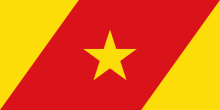Antsokiyana Gemza
Antsokiyana Gemza ("Antsokiya and Gemza") is a wereda in the Amhara Region of Ethiopia. This district is partly named for one of the districts of Shewa, Antsokia. Part of the North Shewa Zone, Antsokiyana Gemza is bordered on the south by Efratana Gidim, on the southwest by Menz Gera Midir, on the west by Geshe, and on the north and east by the Oromia Zone. The administrative center is Mekoy; other towns in Antsokiyana Gemza include Majete.
Antsokia Gemza | |
|---|---|
Woreda | |
 Flag | |
| Zone | Semien Shewa |
| Region | Amhara Region |
| Seat | Mekoy |
| Area | |
| • Total | 372.18 km2 (143.70 sq mi) |
| Population (2012 est.) | |
| • Total | 87,073 |
Local landmarks in this district include the Tomb of Saint Gelawdewos, where the head of the holy emperor of that name was buried in 1562.[2]
Demographics
Based on the 2007 national census conducted by the Central Statistical Agency (CSA), this district has a total population of 79,091, an increase of 7.75% over the 1994 census, of whom 39,327 are men and 39,764 women; 12,547 or 15.86% are urban inhabitants. With an area of 372.18 square kilometers, Antsokiyana Gemza has a population density of 212.51, which is greater than the Zone average of 115.3 persons per square kilometer. A total of 18,710 households were counted in this district, resulting in an average of 4.23 persons to a household, and 18,130 housing units. The majority of the inhabitants were Orthodox Tewahedo, with 74.35% reporting that as their religion, while 23.83% of the population said they were Muslim and 1.81% were P'ent'ay.[3]
The 1994 national census reported a total population for this district of 73,401 in 13,106 households, of whom 36,512 were men and 36,889 were women; 9,964 or 13.57% of its population were urban dwellers. The two largest ethnic groups reported in Antsokiyana Gemza were Amharas (97.63%), and Oromos (2.25%); all other ethnic groups made up 0.12% of the population. Amharic was spoken as a first language by 97.59%, and 2.31% spoke the Oromo language; the remaining 0.1% spoke all other primary languages reported. The majority of the inhabitants were Orthodox Tewahedo, with 75.98% reporting that as their religion, while 23.15% were Muslim, and 0.82% Protestant.[4]
References
- Geohive: Ethiopia Archived 2012-08-05 at the Wayback Machine
- Huntingford 1989, p. 135.
- Census 2007 Tables: Amhara Region Archived November 14, 2010, at the Wayback Machine, Tables 2.1, 2.4, 2.5, 3.1, 3.2 and 3.4.
- 1994 Population and Housing Census of Ethiopia: Results for Amhara Region, Vol. 1, part 1 Archived November 15, 2010, at the Wayback Machine, Tables 2.1, 2.7, 2.10, 2.13, 2.17, Annex II.2 (accessed 9 April 2009)
Works cited
- Huntingford, George Wynn Brereton (1989). The Historical Geography of Ethiopia: From the First Century Ad to 1704. British Academy. ISBN 978-0-19-726055-5.CS1 maint: ref=harv (link)